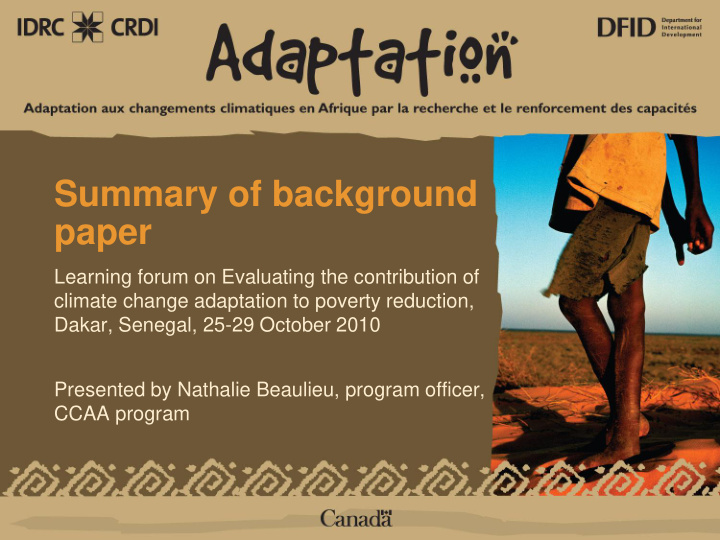



Summary of background paper Learning forum on Evaluating the contribution of climate change adaptation to poverty reduction, Dakar, Senegal, 25-29 October 2010 Presented by Nathalie Beaulieu, program officer, CCAA program
Parts of the presentation Addressing gaps found in current knowledge A few working definitions www.crdi.ca/acca 2
There are « tensions » Adaptation versus development Vulnerability versus poverty There are two-way causal relationships and overlaps www.crdi.ca/acca 3
What is already known It is now widely recognised that poverty is multidimensional and that monetary aspects are ony part of it Causal relationships are most often quite complex so a direct evaluation of the effect of adaptation initiatives on poverty or vulnerability indices might not be meaningful Eriksen et al. (2007) propose to analyse the interface between vulnerability and povery by studying the various processes that lead to failure to secure the four dimensions of basic living standard (as defined by OECD) in the context of climate change www.crdi.ca/acca 4
Also… Different professional communities conceptualise vulnerability in different ways, requiring an explicit definition when using the term Many approaches exist to calculate indices of vulnerability and most of them are asset-based Existing tools for analysing vulnerability are useful to identify most significant hazards, most vulnerable sectors or persons, factors of vulnerability, therefore to plan and target actions. However, their use to track the progress of adaptation initiatives is limited. www.crdi.ca/acca 5
What are the gaps that we want to address? Lack of practically usable tools and criteria allowing to indicate that adaptation is happening and/or adaptive capacity has been strengthened Uncertainties in criteria to evaluate the potential contribution of this adaptation to poverty reduction Insufficient knowledge of the conditions necessary for successful adaptation, mechanisms that work, constraints in different contexts www.crdi.ca/acca 6
How we plan to add to the existing body of knowledge By testing a widely used adaptation approach, contribution analysis, in the climate change adaptation context. Through examples from projects, identify common causal relationships, conditions for successful adaptation and constraints By exploring additional tools and methods that have been used, or could be used, to further study the contribution of adaptation to poverty reduction www.crdi.ca/acca 7
We share these interests with: Agencies who are increasingly mainstreaming climate change adaptation into their development programs, Developing countries and their agencies: they are increasingly doing the same in their poverty reduction strategies Many development operators involved in these initiatives www.crdi.ca/acca 8
A few suggested working definitions for this learning forum Developed from definitions found in the literature as well as from practice www.crdi.ca/acca 9
Adaptation and development Adaptation : Initiatives and measures to reduce the vulnerability of natural and human systems against actual or expected climate change effects (IPCC, 2007) Human Development : the process of enlarging people’s choices. Their three essential choices are to lead a long and healthy life, to acquire knowledge and to have access to the resources needed for a decent standard of living. Additional choices, highly valued by many people, range from political, economic and social freedom to opportunities for being creative and productive and enjoying personal self — respect and guaranteed human rights. www.crdi.ca/acca 10
Adaptation vs development This is not always a positive cause and effect relationship: some development initiatives, if they do not take climate change into account, can reduce the capatity to adapt. Some adaptation initiatives can be detrimental to some groups and decrease their choices. Initiatives that are purely developmental are those that would be necessary even if climate change did not occur (Mc Gray 2007) Initiatives that are purely adaptation are those that aim at solving a problem directly related to a climate-related hazard but are not concerned with other aspects of development www.crdi.ca/acca 11
Adaptive capacity Adaptive capacity, the ability to adapt, is defined as the whole of capabilities, resources and institutions of a country, region, to implement effective adaptation measures (IPCC, 2007). This definition can be extended to individuals and communities. Adger et al. (2004) define it as the capacity of a system to modify or change its characteristics or behaviour to cope with existing or anticipated external stresses. Adaptive capacity is the ability to reduce vulnerability www.crdi.ca/acca 12
Vulnerability Degree to which a system is susceptible to, or unable to cope with, adverse effects of climate change, including climate variability and extremes (IPCC, 2007) What allows a hazard to cause a disaster. Risk=Vulnerability x Hazard (UNDHA,1992 ) The probability or risk today of being in poverty — or falling deeper into poverty — at some point in the future (Coudouel et al, 2002, sourcebook for poverty reduction strategy papers, World Bank) Our definition based on all of the above: The susceptibility of persons or groups to become poor or poorer as a result of climate change related stresses or shocks. www.crdi.ca/acca 13
Poverty Manifestation of insufficient well-being (Bourguignon and Chakravarty, 2003) • Capability deprivation (Sen, 1985) a lack of capabilities that enable a person to live a life he or she values, encompassing such domains as income, health, education, empowerment, and human rights. Note: the capability approach inspired the Human Development Index The criteria to distinguish between poor and non-poor will depend on the values of whoever makes the judgement www.crdi.ca/acca 14
OECD’s definition of poverty: The lack of opportunity to earn an income and meet material needs; maintain health and a basic education; speak up for oneself and have rights; maintain a sense of social and cultural affiliation. www.crdi.ca/acca 15
Vulnerability vs poverty Those most vulnerable are most likely to become poor or poorer as a result of climate change Poverty can also increase vulnerability by reducing the options available to cope and adapt. For example, poor or marginalised people are sometimes forced to live or cultivate in areas that are prone to climate-related extreme events. But those who are vulnerable today are not always poor today www.crdi.ca/acca 16
Any questions? www.crdi.ca/acca 17
Recommend
More recommend